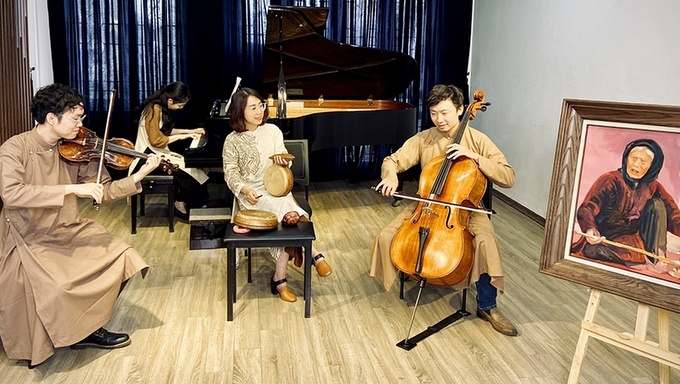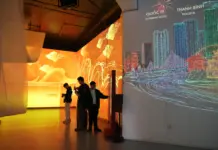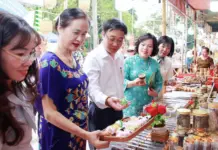Sharing the same passion, they have made their own creative approaches to spread their love to all people, especially their peers.
Born and raised in the Mekong River Delta province of Vinh Long, cai luong (reformed theatre) and the sweet melodies of don ca tai tu (traditional musical art form of the south) from the Mekong River Delta region are an indelible part of child memories of Ho Phuong Thao (also known Thao Ho) and inspire her passion for traditional arts.
Despite working in the field of personnel management in a business, she has also devoted her soul and enthusiasm to various types of folk performances. Travelling to many destinations, Thao Ho and her friends have gained experiences, learned more about and recorded folk art forms from around the country. From that huge amount of material, they have wished to share their acquired knowledge and love for traditional arts with young people. The project of developing an artbook entitled “The art troupe touring everywhere” was launched to introduce different types of folk performances, arts and festivals in many regions and localities. Thanks to experiences under the perspectives of the youths via the book, they will want to enjoy the performances directly to learn more about the special values like Thao Ho and her associates.
Painter Hoang Tan (Tan Nguyen) and young female translator Trieu Giang also participated in Thao Ho’s project. They focused on carrying out the project for the past two years. It was completed and introduced online, during the days of social distancing due to COVID-19, on the death anniversary of the ancestor of Vietnamese stage sector. The group expects to launch new similar publications on different art forms under the framework of the project going forward. The book is not scientific but merely a product from a journey of learning, discovering and the feeling of young people under the guidance and consultancy of many experts and artists.
Immediately after being introduced to the public, Thao Ho’s book has inspired the interest from the public opinions, especially young people on social network communities with interesting information about the origins and features of 30 performing art forms and six folk festivals around the country. Through the book, readers can learn more about Xoan singing (a community performance art from northern Vietnam), quan ho (love duet) singing, ca tru (ceremonial singing), mua roi nuoc (water puppetry), cheo (Vietnamese traditional opera), chau van (spiritual singing) and hat xam (ballads sung by wandering blind musicians) from the northern region; explore Vi-Giam folk music, Hue royal court music and bai choi singing (a popular folklore style of singing) in the central and south central regions; familiarize with ancient tuong (classical drama), don ca tai tu and du ke (singing drama of Khmer people) in the southern region; and learn about unique folk festivals such as Nao Pe Chau (the annual traditional holiday of the Mong ethnic minority group), le cap sac (maturity ritual), Giong festival and praying for rain ritual. Particularly, there are many art forms and festivals with several strange names.
Thao Ho’s team has made great efforts to carry out phases of the project during the outbreak of the pandemic. The nearly-200-page book features around 100 vivid illustrated images to introduce the practice, patterns and instruments for art forms, helping viewers imagine both the similarities and differences of dances and songs in the vibrant performing arts life of the forefathers. Implementing the artbook both in Vietnamese and English, the authors wished to promote the beauty of Vietnamese traditional arts to international friends. In the near future, the project will launch additional products including a set of 36 stickers of various types of art troupes and A3 maps marking the experiences of 36 art forms, towards increasing the interaction of the public on the journey to approach the culture of their ancestors.
Also exploring the folk traditions like Thao Ho and her friends, the group “Cheo 48h – I return to my homeland” from Hanoi developed the programme “Mat xam” with aspirations of “touching” xam through a variety of prisms. Despite taking place in mid-2021 when the pandemic situation was very complicated and crowds were not allowed, the project, with a series of meaningful virtual activities, still attracted great attention. Talks with experts to see Xam in cultural adaptation as well as from the angles of visual arts, performing arts and contemporary music have really brought about interesting perspectives on this precious cultural heritage. The program also featured a multi-sensory exhibition space with fine art and installation works, showing different expressions of Xam.
The group “Cheo 48h – I return to my homeland” in a practice of Xam singing. (Photo: MANH HAO)
Dinh Thi Thao, founder of the group “Cheo 48h – I return to my homeland”, said that over the past six years, on a persistent journey of inspiring and arousing love and pride of national culture for young people, dozens of amateur courses, along with many performances, field trips and forums, on several traditional art forms of Vietnam were held. The project has also aimed at carrying out a series of activities that have highlighted new ways of approaching traditional arts so that they were opened up in a creative and close manner.
Previously, a group of 40 young painters created fine art works and held an exhibition entitled “Painting about boi (classical Vietnamese opera) singing” in Ho Chi Minh City that resonated greatly. They spread the love of traditional arts to young people through the language of modern arts. They also contributed to reviving boi singing stage of the forefathers by using unique and diverse artworks in different materials and methods. Their creative expressions imbued with the imprints of the youth viewers understand the identity of tuong stages as well as the hardships, sacrifices and dedications of the artists in the preservation and promotion of traditional arts. In addition, they organised performances of ancient tuong and public interaction activities by various courses and exchanges with the artists.
Also from “Painting about boi singing”, many personal projects on this art form has been developed in new ways, including paintings in different materials reflecting the characters and artists on stage or behind the scenes by painter Rong Pham or a project of Nguyen Phuong Vy (a final year student from Ho Chi Minh City Fine Arts University) that embedded the information about boi singing with alphabetic characters stylised based on the details of the characters and costumes.
Thao Ho, Tan Nguyen, Trieu Giang, Dinh Thi Thao and Phuong Vy are just some of many young people who are diligently looking for new direction, contributing to the revival of traditional art forms which are at risk of extinction. Through their creative perspective, the young people can not only better understand the traditional arts but also see and experience them in a specific and vivid manner. It is also the way to preserve and promote the cultural heritages of the ancestors in today’s life. According to folklore researcher, Dr. Lu Thi Thanh Le, a lecturer in Vietnamese Studies from Vietnam – Japan University, this is a good sign showing the tendency of returning to the tradition from the young people. The more conditions they have for deep integration and convenient acceptance of global culture, the more clearly, they can identify what belongs to their roots. The curiosity and pride will prompt them to reproduce the traditional values in creative ways. Young people today do not turn their backs on national culture and art, but they still love when they find real vibes.





